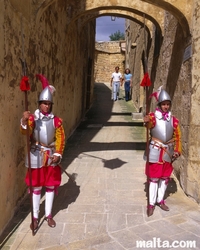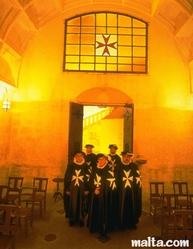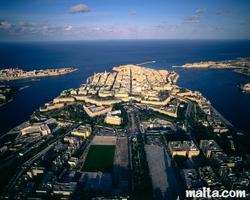The Great Siege of Malta, Knights of Malta and Napoleon
 The Knights of St. John and the Crusades
The Knights of St. John and the Crusades
In 1522, during the time of the Crusades, the Knights of St. John were driven out of Rhodes by the growing Ottoman Empire. Meanwhile, in 1530, Charles V of Spain, out of fear of a possible Ottoman invasion of Rome, granted Malta to the Knights of St John for protection.
The knights fortified and enhanced their new domain and made the Italian language an official one. Because of the ongoing Crusade, the Knights’ main task was to provide medical assistance. They built numerous hospitals and their eight-pointed cross, is still used as a symbol by many first aid organizations today.
The Great Siege of Malta
On the 18th May 1565, The Great Siege of Malta took place when the Turkish Ottoman Empire, a great marine power in the Mediterranean at the time, invaded and tried to capture Malta. The Turks sent 81 ships to attack and over 30,000 soldiers sailed into the Bay of Marsaxlokk, making the siege of Malta the bloodiest and most violent battle in history. During the battle, the Turks lost their commander Dragut Rais along with 8,000 men – around a quarter of their total army in the siege. During the siege, the Turks captured four Knights whom they beheaded and nailed to a cross. As a response, Grandmaster la Vallette beheaded Turkish prisoners and fired their heads from cannons. The Maltese people fought together with the Knights and 8000 Sicilian soldiers, winning the battle against the Turks.
The construction of Valletta
After the siege, fearing another attack, la Vallette decided to increase Malta's fortifications and to build a new city on the previously uninhabited peninsula. The construction of Valletta began on 28 March 1566, with Grandmaster Jean Parisot de la Vallette himself placing the foundation stone. High walls were built for maximum protection, the streets laid out in a grid pattern and a big ditch was dug across the whole of the peninsula. The new city was of course named Valletta in honour of Grand Master de la Vallette who died in 1568, and did not manage to see his city completed.
Fortification of the Maltese Islands
After 1634, Grandmaster Antoine de Paule continued to build fortifications for Malta’s protection designed by Pietro Paolo Floriani. Thanks to the Knights, many architectural and cultural projects saw their light; while many new cities such as Cittá Vittoriosa and Cittá Rohan were built. The Knights not only enhanced and developed Malta but also continued to care for the sick.
In 1674, the Knights began their new hospital, the Sacra Infermeria in Valletta and in 1676 the School of Anatomy and Surgery was set up. Sadly, as time passed, the Knights of St John became drunk with power and lost their support with the Maltese public. Their reign finally came to an end when Napoleon Bonaparte captured Malta.
Napoleon rule and Maltese rebellion
 Napoleon captured Malta on 11th of June 1798, while he was sailing his way to Egypt during the French Revolutionary Wars. The Knights offered Napoleon a safe harbour but denied Napoleon fresh water. As the Knights had lost their former fighting spirit they quickly lost to the French and had to leave Malta.
Napoleon captured Malta on 11th of June 1798, while he was sailing his way to Egypt during the French Revolutionary Wars. The Knights offered Napoleon a safe harbour but denied Napoleon fresh water. As the Knights had lost their former fighting spirit they quickly lost to the French and had to leave Malta.
Even though Napoleon only stayed 6 days, he plundered treasures form the Maltese churches and sailed off to Egypt. He left behind approximately 4,000 soldiers to guard Malta. Napoleon only ruled Malta for about 3 months as on 2 September 1798 the Maltese rebelled against the French at Mdina and the French withdrew to Valletta.
The French stayed in Valletta for the next two years, until General Claude-Henri Belgrand de Vaubois surrendered to British forces on 5 September 1800.
Malta was grateful for the British help and wanted to become a part of the British Empire. They presented the island to Sir Alexander Ball who also accepted the Maltese Declaration of Rights. This stated that Malta would come under the protection of the King and that the King has no rights to hand over the Islands to any other power.


